2008 TOYOTA YARIS SEDAN steering
[x] Cancel search: steeringPage 298 of 384
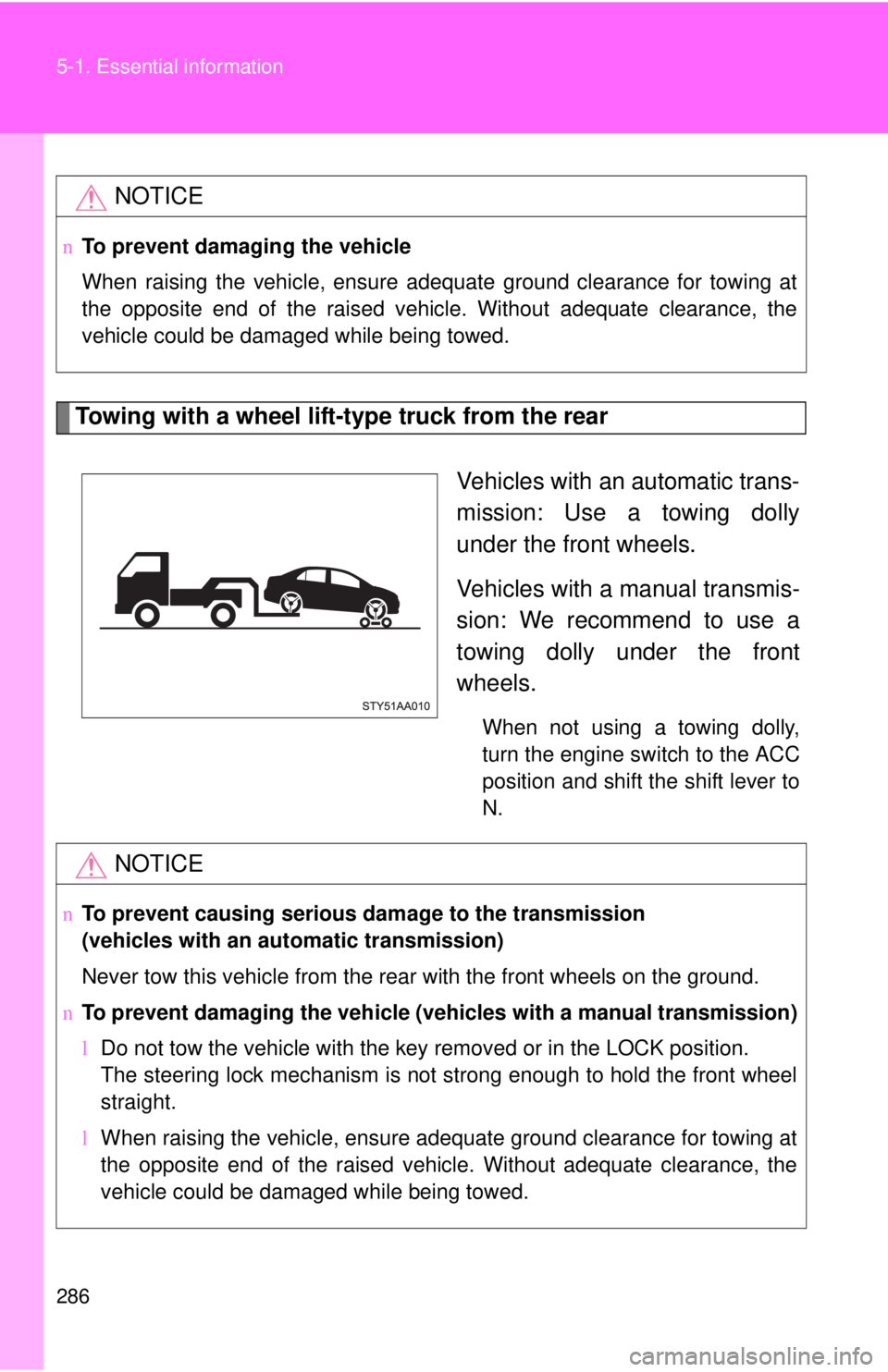
286 5-1. Essential information
Towing with a wheel lift-type truck from the rearVehicles with an automatic trans-
mission: Use a towing dolly
under the front wheels.
Vehicles with a manual transmis-
sion: We recommend to use a
towing dolly under the front
wheels.
When not using a towing dolly,
turn the engine switch to the ACC
position and shift the shift lever to
N.
NOTICE
nTo prevent damaging the vehicle
When raising the vehicle, ensure adequate ground clearance for towing at
the opposite end of the raised vehicle. Without adequate clearance, the
vehicle could be damaged while being towed.
NOTICE
nTo prevent causing serious damage to the transmission
(vehicles with an automatic transmission)
Never tow this vehicle from the rear with the front wheels on the ground.
n To prevent damaging the vehicle ( vehicles with a manual transmission)
l Do not tow the vehicle with the key removed or in the LOCK position.
The steering lock mechanism is not strong enough to hold the front wheel
straight.
l When raising the vehicle, ensure adequate ground clearance for towing at
the opposite end of the raised vehicle. Without adequate clearance, the
vehicle could be damaged while being towed.
Page 306 of 384
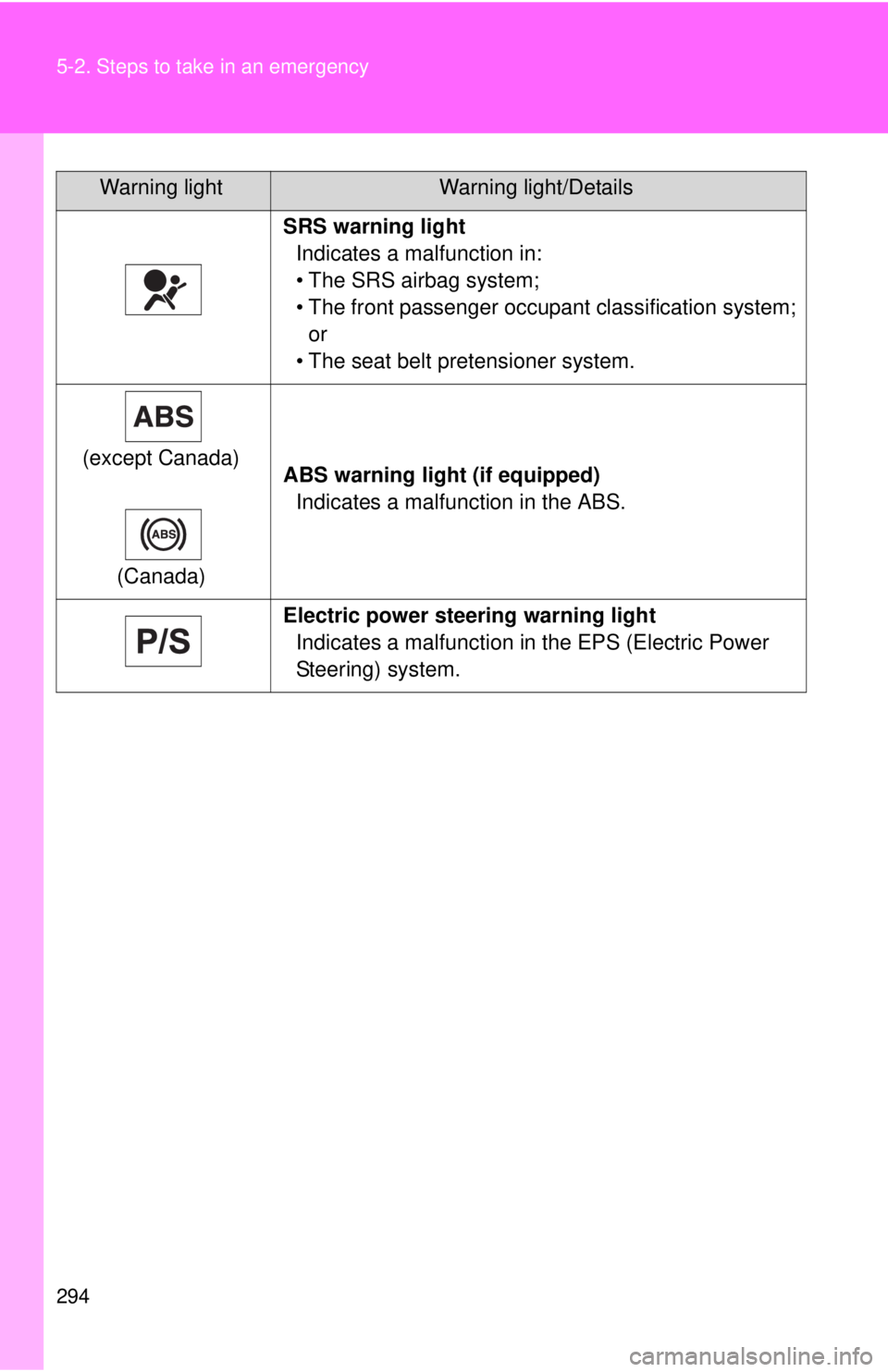
294 5-2. Steps to take in an emergency
SRS warning lightIndicates a malfunction in:
• The SRS airbag system;
• The front passenger occupant classification system; or
• The seat belt pretensioner system.
(except Canada)
(Canada) ABS warning light (if equipped)
Indicates a malfunction in the ABS.
Electric power steer ing warning light
Indicates a malfunction in the EPS (Electric Power
Steering) system.
Warning lightWarning light/Details
Page 313 of 384
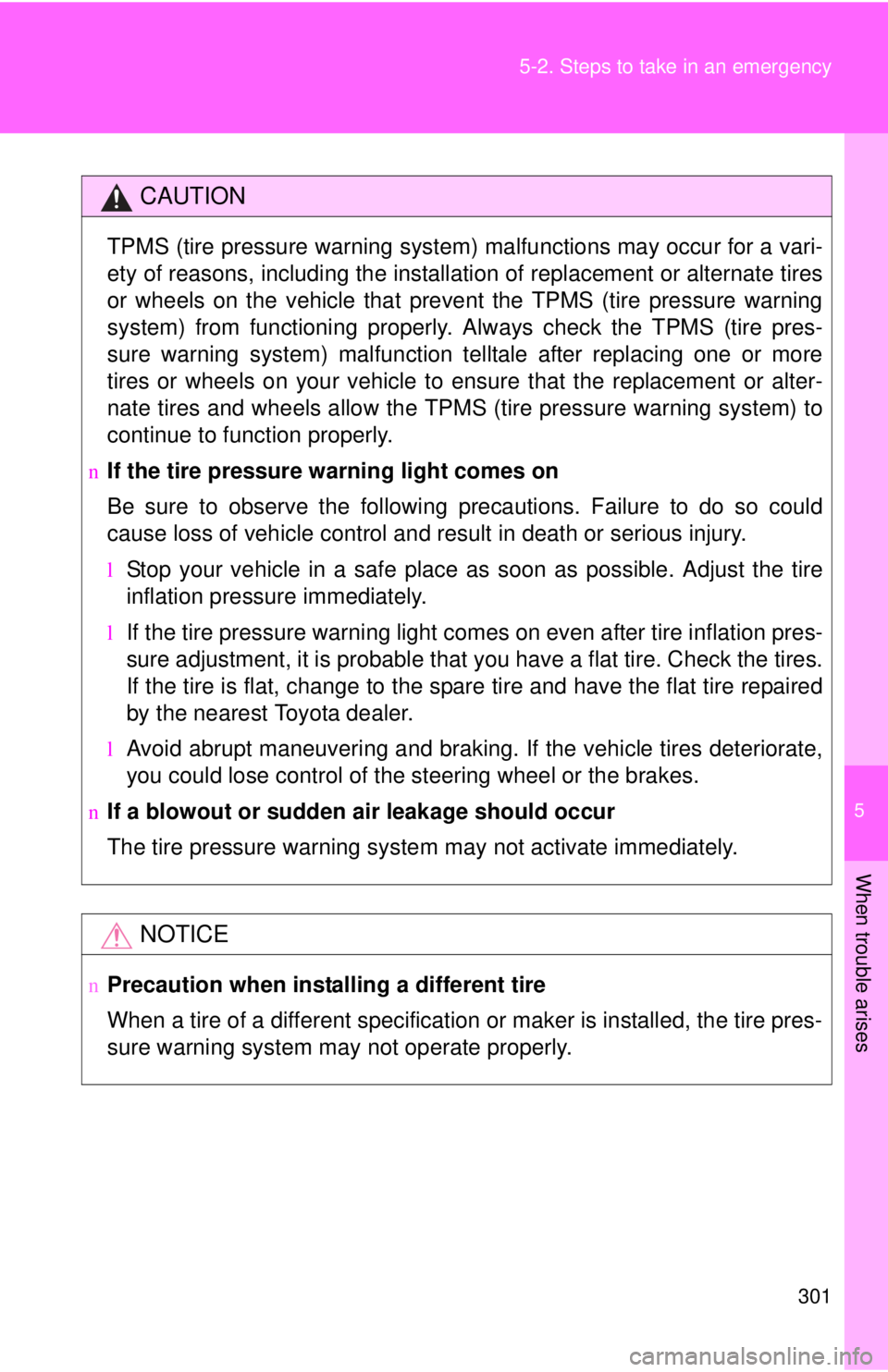
5
When trouble arises
301
5-2. Steps to take in an emergency
CAUTION
TPMS (tire pressure warning system) malfunctions may occur for a vari-
ety of reasons, including the installati
on of replacement or alternate tires
or wheels on the vehicle that prevent the TPMS (tire pressure warning
system) from functioning properly. Always check the TPMS (tire pres-
sure warning system) malfunction te lltale after replacing one or more
tires or wheels on your vehicle to ensure that the replacement or alter-
nate tires and wheels allow the TPMS (tire pressure warning system) to
continue to function properly.
nIf the tire pressure warning light comes on
Be sure to observe the following precautions. Failure to do so could
cause loss of vehicle control and result in death or serious injury.
lStop your vehicle in a safe place as soon as possible. Adjust the tire
inflation pressure immediately.
lIf the tire pressure warning light comes on even after tire inflation pres-
sure adjustment, it is pr obable that you have a flat tire. Check the tires.
If the tire is flat, change to the spare tire and have the flat tire repaired
by the nearest Toyota dealer.
lAvoid abrupt maneuvering and braking. If the vehicle tires deteriorate,
you could lose control of the steering wheel or the brakes.
nIf a blowout or sudden air leakage should occur
The tire pressure warning syste m may not activate immediately.
NOTICE
nPrecaution when installing a different tire
When a tire of a different specification or maker is installed, the tire pres-
sure warning system may not operate properly.
Page 325 of 384
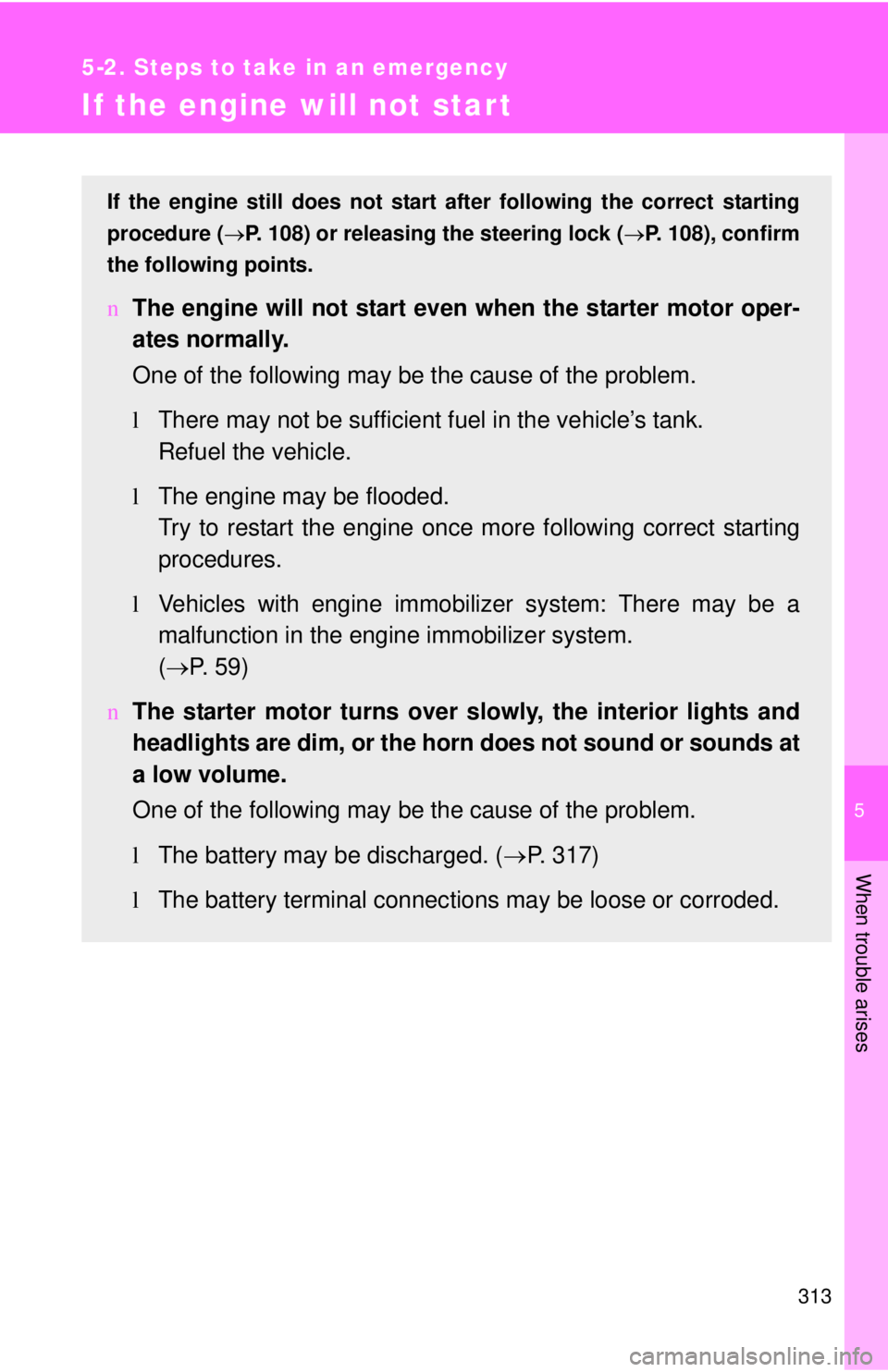
5
When trouble arises
313
5-2. Steps to take in an emergency
If the engine will not start
If the engine still does not start after following the correct starting
procedure ( →P. 108) or releasing the steering lock (→P. 108), confirm
the following points.
n The engine will not start even when the starter motor oper-
ates normally.
One of the following may be the cause of the problem.
lThere may not be sufficient fuel in the vehicle’s tank.
Refuel the vehicle.
l The engine may be flooded.
Try to restart the engine once more following correct starting
procedures.
l Vehicles with engine immobilizer system: There may be a
malfunction in the engine immobilizer system.
( → P. 5 9 )
n The starter motor turns over slowly, the interior lights and
headlights are dim, or the horn does not sound or sounds at
a low volume.
One of the following may be the cause of the problem.
lThe battery may be discharged. ( →P. 317)
l The battery terminal connec tions may be loose or corroded.
Page 343 of 384
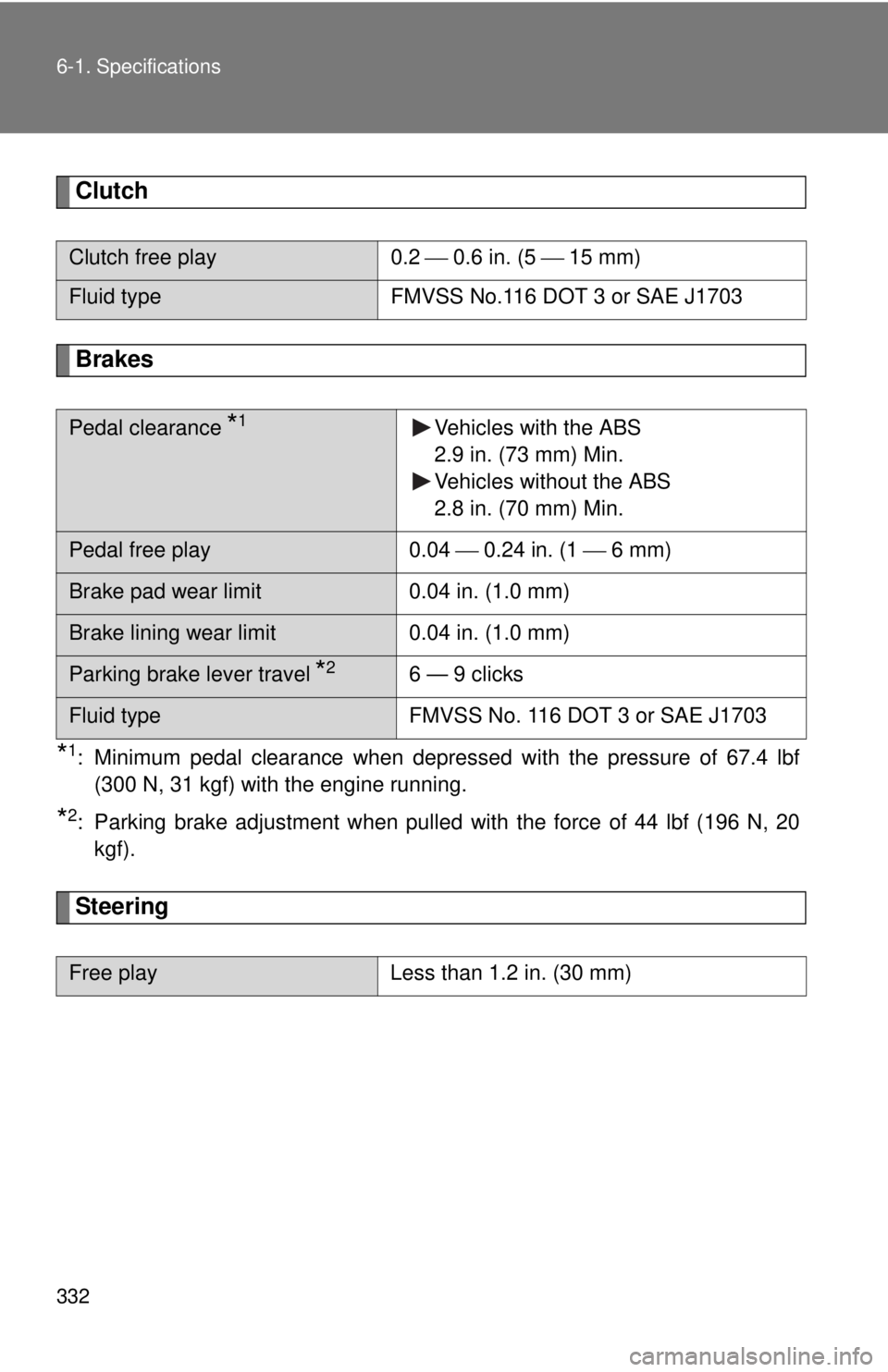
332 6-1. Specifications
Clutch
Brakes
*1: Minimum pedal clearance when depressed with the pressure of 67.4 lbf(300 N, 31 kgf) with the engine running.
*2: Parking brake adjustment when pulled with the force of 44 lbf (196 N, 20kgf).
Steering
Clutch free play 0.2 ⎯ 0.6 in. (5 ⎯ 15 mm)
Fluid type FMVSS No.116 DOT 3 or SAE J1703
Pedal clearance *1Vehicles with the ABS
2.9 in. (73 mm) Min.
Vehicles without the ABS
2.8 in. (70 mm) Min.
Pedal free play 0.04 ⎯ 0.24 in. (1 ⎯ 6 mm)
Brake pad wear limit 0.04 in. (1.0 mm)
Brake lining wear limit 0.04 in. (1.0 mm)
Parking brake lever travel *26 — 9 clicks
Fluid typeFMVSS No. 116 DOT 3 or SAE J1703
Free playLess than 1.2 in. (30 mm)
Page 356 of 384
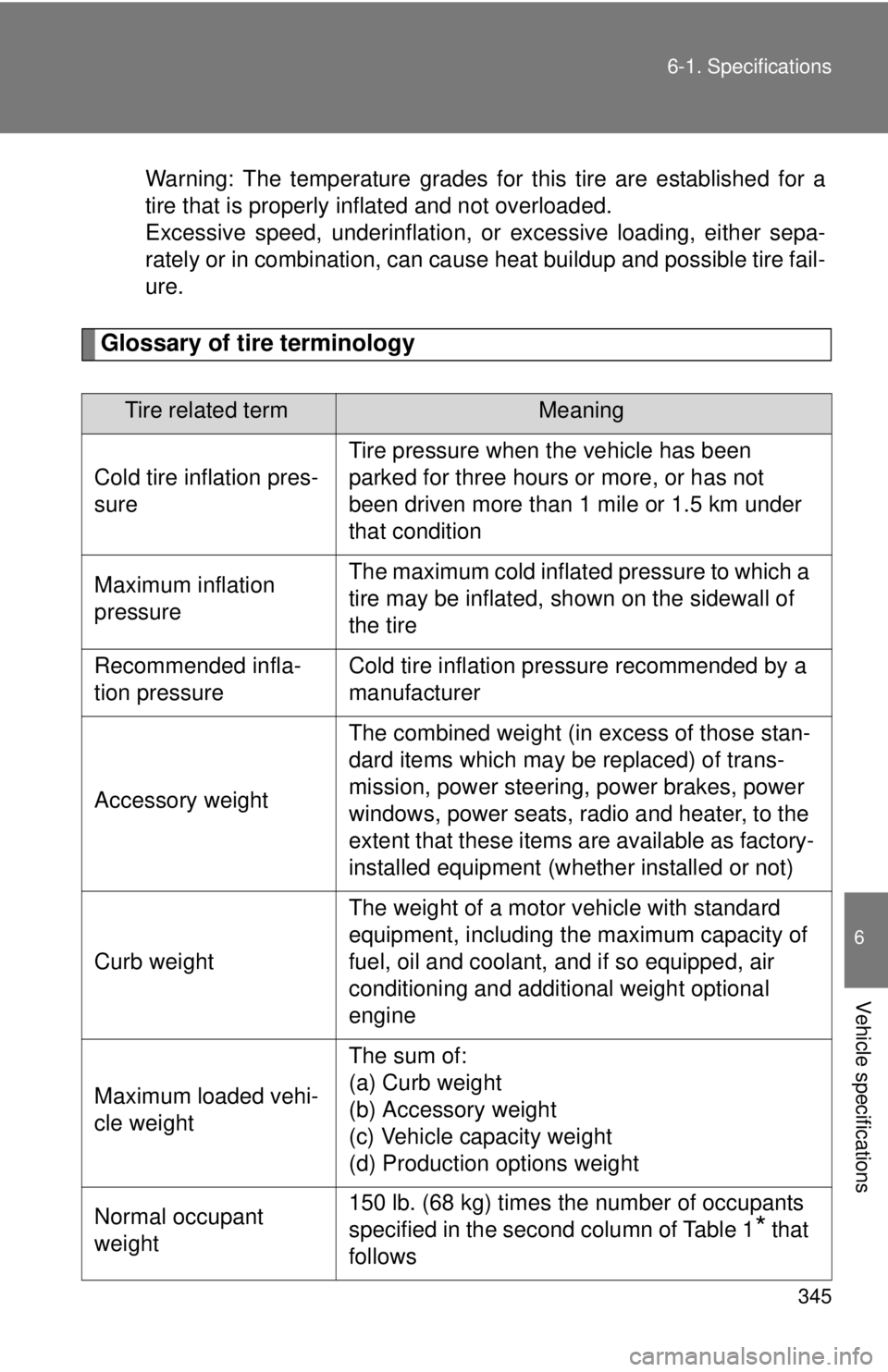
345
6-1. Specifications
6
Vehicle specifications
Warning: The temperature grades for this tire are established for a
tire that is properly inflated and not overloaded.
Excessive speed, underinflation, or
excessive loading, either sepa-
rately or in combination, can caus e heat buildup and possible tire fail-
ure.
Glossary of tire terminology
Tire related termMeaning
Cold tire inflation pres-
sure
Tire pressure when the vehicle has been
parked for three hours or more, or has not
been driven more than 1 mile or 1.5 km under
that condition
Maximum inflation
pressureThe maximum cold inflated pressure to which a
tire may be inflated, s hown on the sidewall of
the tire
Recommended infla-
tion pressureCold tire inflation pressure recommended by a
manufacturer
Accessory weight
The combined weight (in excess of those stan-
dard items which may be replaced) of trans-
mission, power steering, power brakes, power
windows, power seats, radio and heater, to the
extent that these items are available as factory-
installed equipment (whether installed or not)
Curb weight
The weight of a motor vehicle with standard
equipment, including the maximum capacity of
fuel, oil and coolant, and if so equipped, air
conditioning and additional weight optional
engine
Maximum loaded vehi-
cle weight
The sum of:
(a) Curb weight
(b) Accessory weight
(c) Vehicle capacity weight
(d) Production options weight
Normal occupant
weight150 lb. (68 kg) times the number of occupants
specified in the second column of Table 1
* that
follows
Page 370 of 384
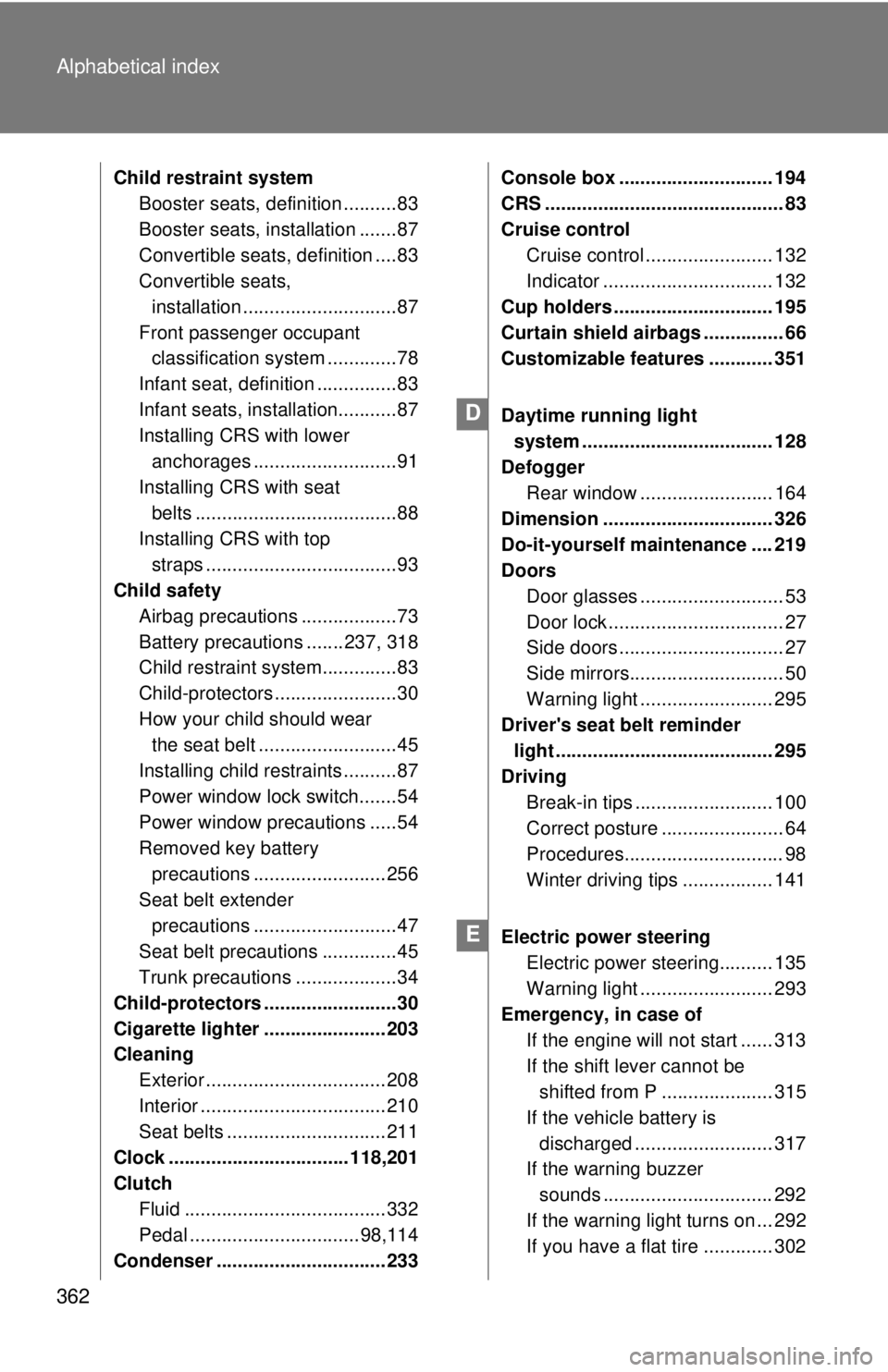
362 Alphabetical index
Child restraint systemBooster seats, definition ..........83
Booster seats, installation .......87
Convertible seats, definition ....83
Convertible seats,
installation .............................87
Front passenger occupant classification system .............78
Infant seat, definition ...............83
Infant seats, installation...........87
Installing CRS with lower anchorages ...........................91
Installing CRS with seat belts ......................................88
Installing CRS with top straps ....................................93
Child safety
Airbag precautions ..................73
Battery precautions ....... 237, 318
Child restraint syst em..............83
Child-protectors .......................30
How your child should wear the seat belt ..........................45
Installing child restraints ..........87
Power window lock switch.......54
Power window precautions .....54
Removed key battery precautions ......................... 256
Seat belt extender
precautions ...........................47
Seat belt precautions ..............45
Trunk precautions ...................34
Child-protectors .........................30
Cigarette lighter ....................... 203
Cleaning Exterior .................................. 208
Interior ................................... 210
Seat belts .............................. 211
Clock ..................................118,201
Clutch Fluid ...................................... 332
Pedal ................................ 98,114
Condenser ................................ 233 Console box ............................. 194
CRS ............................................. 83
Cruise control
Cruise control ........................ 132
Indicator ................................ 132
Cup holders .............................. 195
Curtain shield airbags ............... 66
Customizable features ............ 351
Daytime running light system .................................... 128
Defogger Rear window ......................... 164
Dimension ................................ 326
Do-it-yourself maintenance .... 219
Doors Door glasses ........................... 53
Door lock ................................. 27
Side doors ............................... 27
Side mirrors............................. 50
Warning light ......................... 295
Driver's seat belt reminder
light ......................................... 295
Driving Break-in tips .......................... 100
Correct posture ....................... 64
Procedures.............................. 98
Winter driving tips ................. 141
Electric power steering Electric power steering.......... 135
Warning light ......................... 293
Emergency, in case of
If the engine will not start ...... 313
If the shift lever cannot be shifted from P ..................... 315
If the vehicle battery is discharged .......................... 317
If the warning buzzer
sounds ................................ 292
If the warning light turns on ... 292
If you have a flat tire ............. 302
D
E
Page 372 of 384
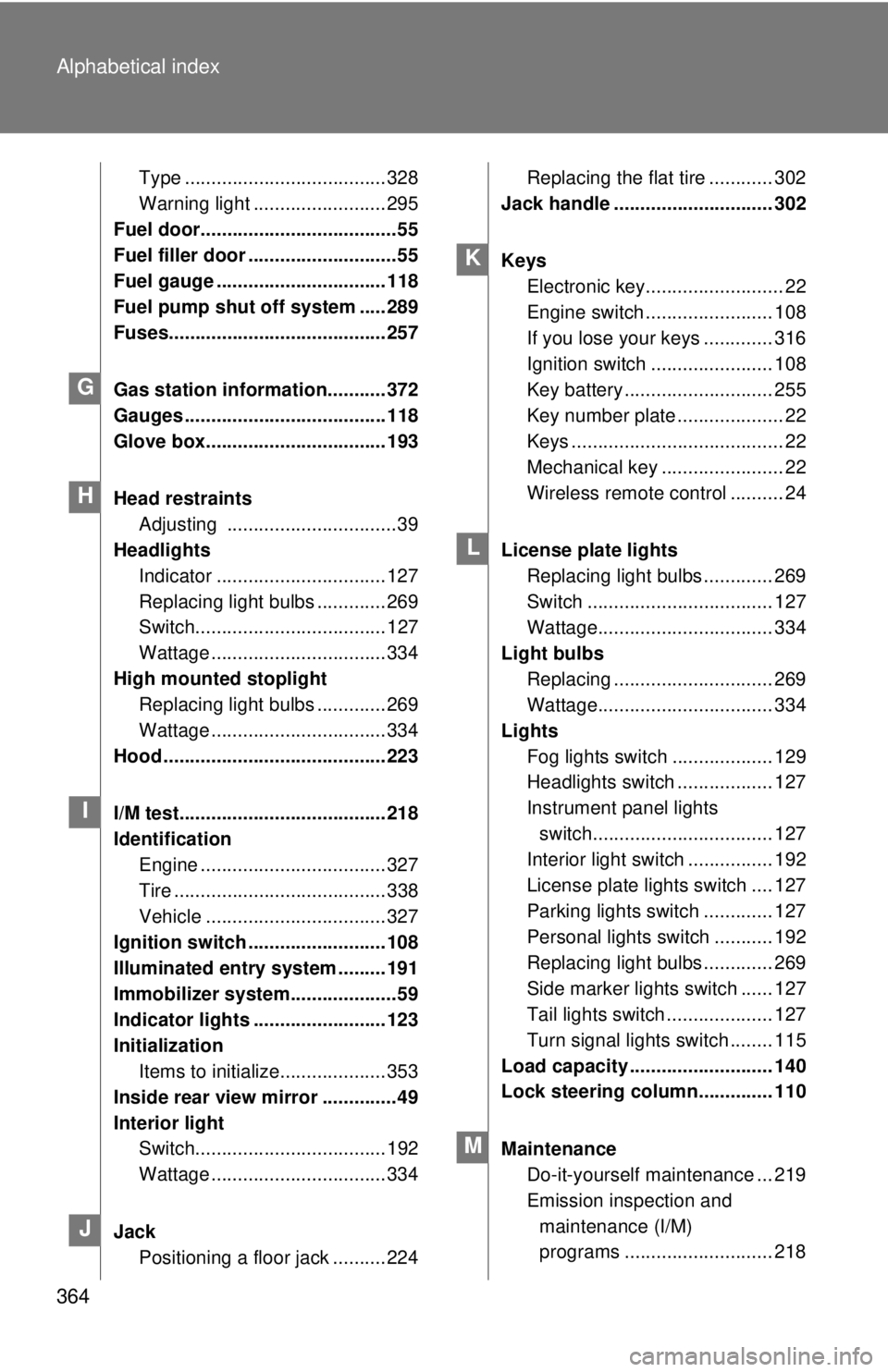
364 Alphabetical index
Type ...................................... 328
Warning light ......................... 295
Fuel door.....................................55
Fuel filler door ............................55
Fuel gauge ................................ 118
Fuel pump shut off system ..... 289
Fuses......................................... 257
Gas station information........... 372
Gauges ...................................... 118
Glove box.................................. 193
Head restraints Adjusting ................................39
Headlights
Indicator ................................ 127
Replacing light bulbs ............. 269
Switch.................................... 127
Wattage ................................. 334
High mounted stoplight Replacing light bulbs ............. 269
Wattage ................................. 334
Hood .......................................... 223
I/M test....................................... 218
Identification Engine ................................... 327
Tire ........................................ 338
Vehicle .................................. 327
Ignition switch .......................... 108
Illuminated entry system ......... 191
Immobilizer system....................59
Indicator lights ......................... 123
Initialization Items to initialize.................... 353
Inside rear view mirror ..............49
Interior light Switch.................................... 192
Wattage ................................. 334
Jack Positioning a floor jack .......... 224 Replacing the flat tire ............ 302
Jack handle .............................. 302
Keys
Electronic key.......................... 22
Engine switch ........................ 108
If you lose your keys ............. 316
Ignition switch ....................... 108
Key battery ............................ 255
Key number plate .................... 22
Keys ........................................ 22
Mechanical key ....................... 22
Wireless remote control .......... 24
License plate lights Replacing light bulbs ............. 269
Switch ................................... 127
Wattage................................. 334
Light bulbs Replacing .............................. 269
Wattage................................. 334
Lights Fog lights switch ................... 129
Headlights switch .................. 127
Instrument panel lightsswitch.................................. 127
Interior light switch ................ 192
License plate lights switch .... 127
Parking lights switch ............. 127
Personal lights switch ........... 192
Replacing light bulbs ............. 269
Side marker lights switch ...... 127
Tail lights switch .................... 127
Turn signal lights switch ........ 115
Load capacity ........................... 140
Lock steering column.............. 110
Maintenance Do-it-yourself maintenance ... 219
Emission inspection and maintenance (I/M)
programs ............................ 218
G
H
I
J
K
L
M